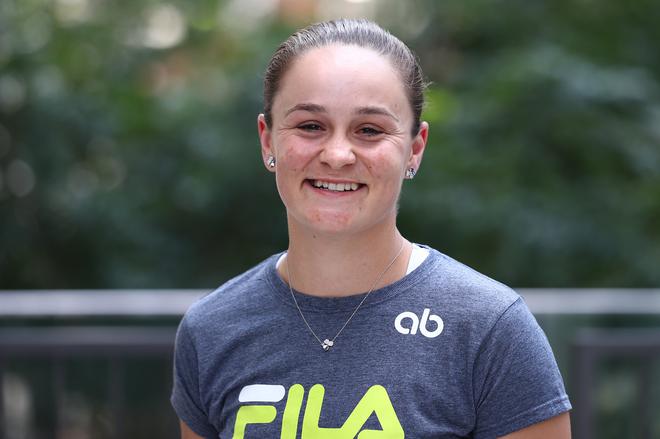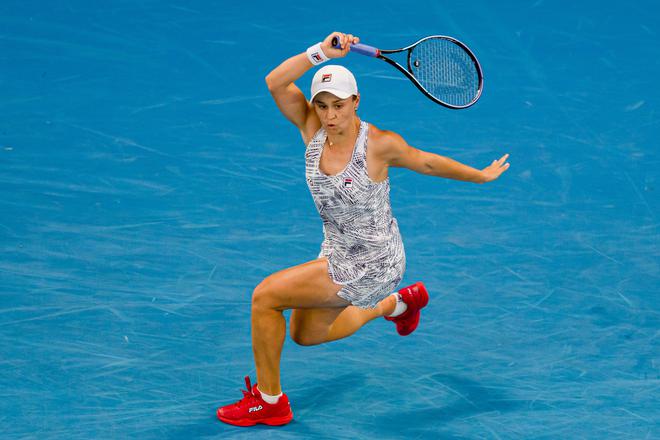

The manner of ending a sports career is an art in itself. It’s the search for a Goldilocks Zone, where the acceptance of sporting mortality can go hand-in-hand with the all consuming desire to write the perfect epilogue that encapsulates all that was achieved earlier.
Sunil Gavaskar managed that across 264 balls on a minefield of a pitch in Bengaluru in 1987, scoring a masterful 96 in an awe-inspiring last stand. Pete Sampras raged against the dying of light over 14 days at New York in 2002, winning the US Open for his 14th Major.
Ash Barty’s curtain call took all of six minutes and six seconds, on Instagram, in the company of good friend and former doubles partner Casey Dellacqua, on an autumnal morning in Australia. As she said: “There is no right way, there is no wrong way, it is just my way. This is perfect for me.”
It was probably the fitting end to a career that indeed resembled a glorious but short fall sunburst, the foliage and flowers painted in myriad colours, leaving a sense of visual opulence that is sure to last a lifetime.
It appears — in hindsight — that Barty, 25, had prepared well for this moment. Just that it was encrypted in plain sight. Part of the rising wave of Australian prodigies along with Nick Kyrgios and Bernard Tomic, she won the junior Wimbledon title in 2011, only to walk away from the sport after the 2014 season, burnt out, and try her hand at Women’s Big Bash League cricket.
On her return in 2016 after having rediscovered her hunger, and after winning each of her three Grand Slam singles titles — 2019 French Open, 2021 Wimbledon and 2022 Australian Open — she spoke of joy and fulfilment. The triumph at Roland-Garros was the first for an Australian woman in 46 years after Margaret Court; Wimbledon the first since Evonne Goolagong Cawley won in 1980; Australian Open the first since Chris O'Neil’s victory in 1978.
But each of these successes was treated as an end in itself. “I wanted to walk away regardless of whether I won a title. The titles, the money and the fame are so irrelevant in terms of success,” she said. Relentless pursuit of sporting excellence was not for her. As Emma Kemp wrote in the Guardian, “Barty redefined what sporting success looks like — as quality, not quantity.”
Barty’s game mimicked this outlook. It seemed at once accessible and at the same time otherworldly. She didn’t quite play shots, as it was popularly remarked, but points. A highlight reel could never do justice to her creativity and ball-striking finesse. One had to witness Barty paint the whole canvas, not just parts of it.
She had one of the most effective and accurate serves on tour and a solid forehand, two quintessential modern weapons that often combined for a knockout one-two punch. But what terrorised her opponents — especially those who hit with linear power from the baseline — was her exemplary backhand slice, which was more than just a neutraliser, often helping her find the space and time to showcase her other strengths.
Rare ability
Barty also had a rare ability to complement the slice with a steady two-handed backhand drive, a vicious drop shot and a well-disguised inside-in. Combined with a safe net game and speedy movement, it made her a complete player.
It was no surprise that she won Slams on grass, clay and the acrylic and occupied the No. 1 spot, until she retired, for 114 consecutive weeks, the fourth-best streak behind Steffi Graf (186 weeks), Serena Williams (186) and Martina Navratilova (156).
A part-frozen, part-rejigged points system in the wake of the COVID-19 pandemic played its role, but at no point did her position seem undeserved. She was that rare stable No. 1 in a women’s game that has been in a state of perpetual flux.
The other reason the Barty halo shone ever brighter was because she was a consummate, all-round athlete. Australia is a country that lives outdoors and Barty was its perfect embodiment. She could have turned her hand to any sport and succeeded.
“She was watching a golf tournament on TV,” Dave Richards, Barty’s former coach at Queensland Cricket, told the cricket quarterly The Nightwatchman. “She turned around and said: ‘I reckon I could have a go at that.’ She went out the following day and shot a round of 81. Eighty-one! That was the first time she had ever picked up a set of clubs. It gives you an idea of the kind of talent we were dealing with.”
“You force a chip-slice backhand, then a quick switch to a volley — forcing her to practise her transition — and she would nail it,” Jim Joyce, Barty’s coach when she started tennis as a four-year-old, would tell the Sydney Morning Herald. “You can try those things with all girls, but they can't all do it.” Joyce is said to have also given Barty a few priorities: to be a good person; to show respect; to have fun; and to be happy. Barty ensured she did all of that.
People’s champion
She was a people’s champion, a magnetic personality like the legendary Usain Bolt, but being Barty, she was less flashy and more modest. She took everyone along on her journey; camaraderie mattered to her more than anything. It is perhaps why cricket appeared attractive. Australia, in fact, has a glorious history of excelling in team sports. Think of all the great cricket and hockey teams they built, the string of Davis Cup successes, Tony Roche and John Newcombe, Todd Woodbridge and Mark Woodforde.
During her victorious 2021 Wimbledon campaign, she was often pictured playing mini Australian rules football games with her team in the mornings. “You have to. That is the journey and the best part about everything,” she would say later. “All of the opportunities I get to do, I get to do with the people that I love. People who have given so much of their time to help me be the best that I can be. We laugh every day, we smile every day. Sometimes it is harder but the best moments, I want to share it with them.”
Everything Barty did seemed to have purpose attached. Of indigenous Australian heritage, one of the first things she did after winning the Australian Open was to spend time playing with children in Uluru, a place sacred to the country’s native aboriginal people. “I think it brings people together, first and foremost,” she would say of the visit. “It allows people to feel safe in an environment.”
Sports careers, despite the greatest of achievements, can seem constantly in search of meaning. Rafael Nadal’s apparently didn’t fully acquire it — according to his die-hard fans — until he won a second Australian Open to give him at least two wins at each of the four Majors. Serena Williams’ supposedly will, when she ties Court’s record of 24 Majors.
But equally, players have found nirvana with far less success, like Jana Novotna at Wimbledon 1998 and Goran Ivanisevic at Wimbledon 2001.
Barty, though, seemed to exist in that rare state of enlightened being from start to finish, impervious to the transient feelings of heightened joy and extreme sadness that are common in sport, captive neither to the past nor the future, delightfully present in a Goldilocks Zone of her own.







